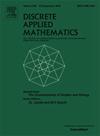The completely independent spanning trees in P4-free graphs
IF 1
3区 数学
Q3 MATHEMATICS, APPLIED
引用次数: 0
Abstract
Hasunuma has conjectured that every -connected graph admits completely independent spanning trees. Pai et al. showed the conjecture is true for complete graphs, complete bipartite graphs and complete tripartite graphs, all of which are -free. Chen et al. showed there exist two completely independent spanning trees in every 4-connected -free graph. In this paper, we further discuss the completely independent spanning trees in both complete multipartite graphs and -free graphs. Let be a complete -partite graph, where We first prove that contains completely independent spanning trees. This implies that every -connected complete -partite graph admits completely independent spanning trees if its order is at least We further provide the upper and lower bounds of the maximum number of completely independent spanning trees in complete -partite graphs, and demonstrate that these bounds are tight. Second, we show there exist completely independent spanning trees in every -connected -free graph of order at least Finally, we construct a kind of minimum -free graphs that contain completely independent spanning trees.
P4-free图中的完全独立生成树
Hasunuma推测,每个2k连通图都有k棵完全独立的生成树。Pai等证明了这个猜想对于完全图、完全二部图和完全三部图都成立,它们都是P4-free的。Chen等证明了在每一个4连通P4-free图中存在两棵完全独立的生成树。本文进一步讨论了完全多部图和p4自由图的完全独立生成树。设Kn1,n2,…,nm为完全m部图,其中n1≤n2≤⋯≤nm。首先证明了Kn1,n2,…,nm包含min{⌊12∑i=1m−1ni⌋,⌊13∑i=1mni⌋}完全独立的生成树。这意味着,每一个2k连通的完全m部图,如果其阶数至少为3k,则允许有k棵完全独立的生成树。我们进一步给出了完全m部图中完全独立生成树的最大数目的上界和下界,并证明了这些上界是紧的。其次,我们证明了在每一个至少3k阶的2k连通p4自由图中存在k个完全独立的生成树。最后,构造了一类包含m棵完全独立生成树的最小p4自由图。
本文章由计算机程序翻译,如有差异,请以英文原文为准。
求助全文
约1分钟内获得全文
求助全文
来源期刊

Discrete Applied Mathematics
数学-应用数学
CiteScore
2.30
自引率
9.10%
发文量
422
审稿时长
4.5 months
期刊介绍:
The aim of Discrete Applied Mathematics is to bring together research papers in different areas of algorithmic and applicable discrete mathematics as well as applications of combinatorial mathematics to informatics and various areas of science and technology. Contributions presented to the journal can be research papers, short notes, surveys, and possibly research problems. The "Communications" section will be devoted to the fastest possible publication of recent research results that are checked and recommended for publication by a member of the Editorial Board. The journal will also publish a limited number of book announcements as well as proceedings of conferences. These proceedings will be fully refereed and adhere to the normal standards of the journal.
Potential authors are advised to view the journal and the open calls-for-papers of special issues before submitting their manuscripts. Only high-quality, original work that is within the scope of the journal or the targeted special issue will be considered.
 求助内容:
求助内容: 应助结果提醒方式:
应助结果提醒方式:


